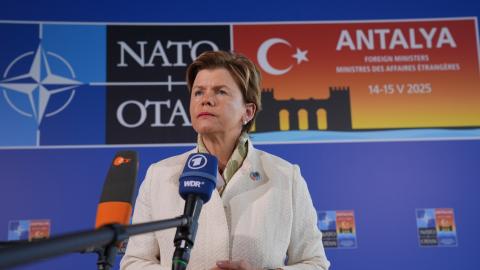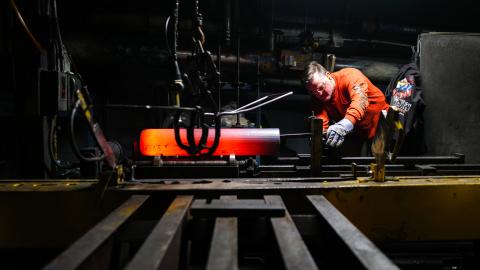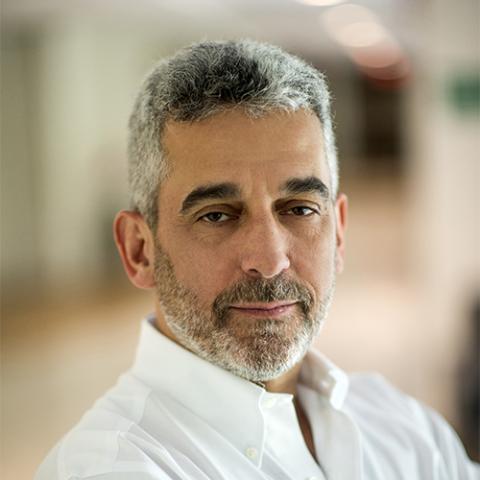Postmodernists long ago disabused us of the idea that texts have stable, fixed meanings. French literary critics like Jacques Derrida and Roland Barthes introduced a vision of the text as a tricky, shape-shifting improvisation; their American disciples like Stanley Fish proposed that these texts only acquire meaning through the efforts of interpretive communities. The relevance of academic critical esoterica to Americas ever-shifting Middle East policiesand how they are understood by Middle Easterners and manipulated by Middle Eastern regimesmay not seem immediately clear. But bear with me.
Recently, Secretary of State Hillary Clinton explained that the biggest threat to Americas national security comes not from Iran but al-Qaida. Most of us believe the greater threats are the trans-national non-state networks, Clinton said, referring to the fundamentalist Islamic extremists who are connected to al-Qaida.
What Clinton meant certainly seems straightforward enough. Transnational, nonstate Sunni jihadi networks like al-Qaida are responsible for not only 9/11 but also attacks on U.S. forces in Iraq and Afghanistan. They have dispatched at least one suicide attacker, the Detroit Christmas bomber Omar Faruq Abdulmuttalab, and apparently have plans to send more. While it is arguable whether a shadowy network of terrorists led by a man who may or may not be alive is more dangerous than an Iranian regime with terrorist assets throughout the Middle East and a nascent nuclear program, Clintons assertion is hardly ridiculous. Its not outside of the realm of possibility that we could still sit down and strike a Grand Bargain with the Islamic Republic, whereas we dont even have a working phone number for al-Qaida.
For the interpretive community that forms itself around the products disseminated by the American mediathat is, for New York Times readers, Washington Post readers, and the CNN audienceWashingtons apparent about-face is due to the desire of the current White House to do the exact opposite of its unpopular predecessor. But a Middle Easterner hears something else.
For the interpretive communities of the Middle East, who watch Al Jazeera and are acutely sensitive to sectarian language that may well affect their lives and the fate of their communities, al-Qaida is shorthand for Saudi Arabia and the Sunnis. So, when Hillary Clinton talks about the dangers posed by al-Qaida being greater than the dangers posed by Iran, a Middle Easterner hears that the Americans are dropping the Sunnis and siding with the Shia. That is to say, what a Middle Easterner hears is the beginning of a new chapter in the grand narrative of strategic realignmentthe epic poem of todays Middle East.
The real question in the region, as Middle Easterners understand it, isnt on the daily agenda of Washington policy chatter about whether to engage Iran or talk to terrorists. Rather, its the very practical and immediate question of how the Americans will use their power to tilt the regional order. Will the United States stick with the Saudis or throw its weight behind Iran?
The Sunni-Shia split goes back 1,400 years, and the conflict pitting the Saudis against the Islamic Republic of Iran dates to the 1979 revolution. But the campaign for strategic realignment began in the immediate aftermath of Sept. 11. With the Americans angry at the Sunnis, and Riyadh in particular, over the attacks, the Iranians saw a window of opportunity to push their case that, despite their recent differences, they were Americas logical strategic partner in the region. U.S. policymakers who wanted rapprochement with Tehran agreed.
The State Department Policy Planning staff drafted a recommendation to the president for an opening to Iran in response to Sept. 11, says Steven Rosen, director of the Washington Program at the Middle East Forum. Richard Haass and Flynt Leverett stayed up all night to write it on Sept. 11, and the next morning Secretary Powell walked it over to the White House. While the rest of the country was reeling from the attacks, they saw in 9/11 an opportunity for engagement with Iran. They assumed the Iranians would of necessity be opposed to a Sunni organization like al-Qaida, and here was a way for Iran to prove its bona fides with the U.S. President Bush accepted the idea of testing the Iranians intentions, but the White House was much less hopeful about Irans response than Leverett and Haass.
A number of stories surfaced to explain why U.S.-Iranian rapprochement hit a wall. It seems there has been a debate inside the [U.S.] government over whats the biggest dangerIran or Sunni radicals, Vali Nasr, then a fellow at the Council on Foreign Relations and now an adviser to top U.S. diplomat Richard Holbrooke, told The New Yorkers Seymour Hersh in 2007. The Saudis and some in the Administration have been arguing that the biggest threat is Iran and the Sunni radicals are the lesser enemies. This is a victory for the Saudi line.
While this perspective dovetails nicely with the struggle over strategic realignment narrative, it is an inaccurate appraisal of what really happened. The previous Bush administration did not view the issue in terms of Sunnis vs. Shia or Saudi vs. Iran. Rather, it believed that the most serious strategic threats to U.S. interests could be found in places where state sponsors of terror intersected with transnational terrorist groups. In theory, Tehran and Riyadh were equally problematic. In practice, however, the Iranians and their Syrian allies were fighting the United States in Iraq while their assets, like Hezbollah and Hamas, were challenging American allies in the Palestinian territories, Israel, Lebanon, and Egypt. Meanwhile the Saudis, the worlds swing producer of oil, were at least nominally on our side. Indeed, in May 2003, an operation against Saudi Arabia that was planned and directed by al-Qaida leadership in Iran killed eight Americans.
If Vali Nasr was correct, Hillary Clintons statement is evidence of a major victory for the Iranian lineand Nasr, the Iranian-American author of The Shia Revival, seems like one of the messengers. As an advocate of U.S. realignment with Iran, he has a personal stake in such an outcomeand as a Holbrooke aide in the State Department hes also well placed to shape the secretary of States message to the world. Game and setif not yet the entire matchto Iran.
But Clinton meant nothing like that. In plain American-speak, she was simply saying that the Obama administration has accepted the inevitability of an Iranian nuclear program and is now hard at work getting American citizens and U.S. allies comfortable with that unpleasant fact. The Middle Eastern interpretation of her remarks is simply wrong.
But, in a sense, it doesnt matter what Clinton meant to say: The meaning of a text is not up to its author alone; rather, its meaning is the product of an open-ended communal process. Reading like a Middle Easterner means believing that every story in the U.S. press about the Middle East is the fruit of a long campaign involving competing interests who operate in a conspiratorial way, whether those interests are different branches of the U.S. government, agents of foreign governments, or both. For instance, a 2007 Thomas Friedman column in the New York Times arguing that Irans history and culture make it a much more likely U.S. ally than obscurantist Saudi Arabia signals that Tehran is winning the case in Washington for strategic realignment. A column his colleague Maureen Dowd wrote earlier this month, praising the Saudis for their liberal reforms, shows that Riyadh is fighting back and has powerful bureaucratic allies on its side, too.
We know that columnists like Friedman and Dowd are merely private citizens whose arguments are not being crafted in the State Department or the Pentagon. However, it is precisely our certainty that U.S. journalists are working within the norms of American media that makes us vulnerable to information operationsinstruments of political subterfuge employed by all Middle Eastern regimes and intended to shape perceptions, and, therefore, real events.
Reading like a Middle Easterner requires a discriminating taste for conspiracy that enables the reader to separate the real conspiracies from the false ones. A corollary of this fact is that sometimes the paranoid style of the Middle East is much more suitable than the American faith in transparency for understanding what we read.
A few weeks ago, for example, I got a call from pro-government friends in Lebanon who wanted to know when Syrian President Bashar al-Assad gave his most recent interview to Seymour Hersh. The date, they believed, would indicate whether or not one of Assads statements in that interview was a threat to destabilize Lebanon. Clearly the Hersh interview was not the final straw that broke the will of Lebanons pro-democracy movement and compelled them to make amends with Damascus, but it was part of a long and successful information operations campaign waged by Syria against U.S. alliesa campaign that included Hershs interview with Assad, which appeared on the The New Yorkers website.
I love Seymour Hersh, a friend told me one night in Beirut. It doesnt matter if what he writes is nonsense, I love the storytelling. Hersh, perhaps only half consciously, has been the main chronicler of the struggle for strategic realignment, its bard, over the better part of the last decade. Its well known in Washington that his New Yorker stories serve as an instrument for those on the losing side of the Beltways bureaucratic wars. Whats less obvious is that Hershs hostility toward the Bush administration signaled to publicists in the Middle East that he was a likely channel for a pro-Iran narrative about a dim-witted American president who was steering the United States toward disaster through his poor taste in regional allies.
As is the case with other Western journalists who write about Irans allies and assets in the Eastern Mediterranean, Hershs access to high-profile figures like Assad and Hezbollah General Secretary Hassan Nasrallah is controlled by Lebanons former minister of information, the pro-Iranian, pro-Syrian, and pro-Hezbollah apparatchik Michel Samaha. This leverage gives Samaha, as it would for any celebrity publicist, a significant role in shaping Hershs stories. In 2004, Samaha told Hersh that Israel had programmed the Kurds to do commando operations throughout the region. At the time, this well-placed piece of gossip was useful to Samahas clients. The same was true of the message that al-Qaida is equivalent to Saudi Arabia, which Hersh has also transmitted. Think of Hersh as a celebrity profile artist for Vanity Fair and Samaha as a powerful Hollywood publicist like Pat Kingsley, except one whose associates assassinate rivals.
The dark power behind Samahas PR operation is Jamil al-Sayyid, a former Lebanese security chief who is believed to be involved in the assassination of former Lebanese Prime Minister Rafiq al-Hariri. Accordingly, part of the Samaha groups message is to suggest that Hariris son Saad, Lebanons current prime minister, funds al-Qaida affiliates, another campaign helpfully conveyed by the prize-winning reporter. Hersh has even internalized the slogans of his handlers, excitedly explaining to CNN that the Bush administration and the Saudis were backing al-Qaida via the Lebanese government. Four months after the interview on CNN, Hershs account was exposed as a fabrication when Lebanons Sunni prime minister ordered the army to take down a Sunni jihadi group in a bloody battle that was won thanks in part to generous U.S. arms shipments to the Lebanese Army.
Gullible New Yorker readers and CNN viewers were never the primary audience for the message Hersh carried. Rather, when the pro-Iran media turned and quoted Hersh on a story fed to him by the pro-Iran camp, the point of the operation was to get two of the U.S. medias flagship organizations to whitewash a disinformation campaign intended for internal consumption in the Middle East, a operation whose goal was to convince swing states in the region to move away from the United States and its allies.
In recent weeks, the Iranian narrative of strategic realignment has hit the mainstream again, in a Washington Post op-ed by Robert Malley and a long analytical article from Stratfors George Friedman. Savvy American readers are likely to regard the apparent coincidence as another media trend. But if youre a Middle Easterner seeking to make sense of the statements of American public officials and editorialists, the resurgence of the Iranian line is a clear sign that the Obama administrations regional policy is a mess and that the grand narrative of realignment is once again in play.
















